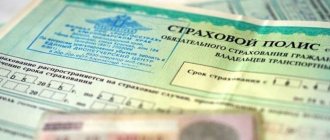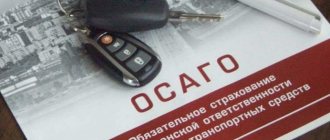What does the MTPL insurance class mean?
The class of compulsory motor third party liability insurance characterizes the relationship between the driver and insurers.
The main indicator is the number of accidents resulting in insurance compensation. When contacting an insurance company for the first time, the initial level is determined by “3” class.
It also applies to drivers who have extensive experience, but have not previously taken out MTPL. In exceptional cases, insurance companies may assign a higher category, but this is not enshrined in any rules. The class indicator does not affect the calculated value of the basic cost of the insurance premium.
When determining it, the following information is taken into account:
- about the car (type, make, engine power, service life);
- driver (age, driving period, place of residence);
- insurance history.
The absence of traffic accidents during the year increases the driver's class. Insurance indemnity is reduced. Exactly how much of a decrease occurs is examined using a special table.
The bonus-malus coefficient (Bm) is directly related to the insurance class. Each level is assigned its own index. When the class increases, it decreases by 5%. When it decreases, it increases.
It is useful to know your KBM, since the final price of compulsory motor vehicle liability depends on its value. For example, with Kbm = 0.5 the basic package will cost 2 times less, and with Kbm = 2.3 it will cost 230% more.
To do this, you will need to enter your personal data and driver's license number.
Until 2007, KBM, and therefore the class, were tied to the car. Its replacement led to a loss of class and a decrease in the coefficient, to an increase in the cost of compulsory motor insurance.
Now KBM will relate to the driver, his level of driving skill, and accident-free driving.
The innovation allows you to avoid tricks, both from drivers and insurers. Unscrupulous drivers will not be able to obtain insurance under MTPL, while maintaining their class and KBM by switching to another insurance company. Insurance companies will not be able to unreasonably raise the price of insurance due to changes in the KBM.
How does a driver’s class determine the cost of compulsory motor liability insurance?
The driver's class when taking out insurance under MTPL plays a key role in determining the cost of the service. The price is calculated based on the following data:
- Each type of vehicle has its own tariff (buses, cars, freight transport);
- For each make and model, special tariffs are developed taking into account the frequency of their accidents;
- Place of residence . Each region has its own accident statistics - accordingly, the coefficient is calculated based on statistical data;
- Young drivers are given higher odds, while more mature drivers are given lower odds. You can also add driving experience , which often directly depends on the driver’s age;
- Driving history. Depending on this indicator, insurance services calculate the BMR and determine the driver’s class.
If there is some clarity with all the parameters, then questions may arise with driving insurance classes. So, the MTPL insurance class - what is it and what are its features?
Insurance classes for drivers
According to the OSAGO system, the following classes are determined: 0, M, 1, 2 ... 13. If the driver does not have an insurance history, he is assigned a coefficient of 1 by default. This means that when calculating the cost, all of the above factors are taken into account, except the last one. With each year of driving experience without contacting insurance services for compensation, the driver will receive a higher class. Also, for each class, the corresponding BMR is calculated, which allows you to reduce the amount of annual insurance premiums by 5%. Accordingly, for the fourth class (the actual designation is class 2) the indicator is set to 0.95, for the fifth class the coefficient after a year becomes 0.9, etc., in decreasing order. In case of receiving the last class, the driver is given a 50% discount on the cost of the insurance policy.
Note that for each insurance situation (for example, an accident), the price of insurance under compulsory motor liability insurance increases and the class decreases. The minimum possible M-class for a driver provides 145% of the compulsory motor liability insurance price, since the coefficient itself for this class reaches 2.45. As a rule, this class is awarded to drivers who received compensation from the insurance company more than four times in a year. A decrease in the amount can only be gradual, in contrast to the situation with an increase.
What does it mean?
In order to understand what driver class 3 means in MTPL, you should first understand the term “driver class” itself used by insurers. Driver class is a value that insurers can designate either by a letter (for example, M) or by a number (from 0 to 13). The minimum driver class is designated in compulsory insurance by the letter M, while the highest possible class is designated by the number 13.
KBM, in turn, can either increase or decrease the cost of this insurance product. Driver class 3 is assigned to those drivers who insure their car for the first time or sign up for a compulsory insurance contract. In class 3, the driver is assigned a BMI value equal to 1, that is, with such a BMI, the final cost of insurance does not change in any way and the policyholder pays the full cost of insurance.
If the driver does not cause an accident within a year, he is assigned the fourth class and, accordingly, he receives a discount of 5% of the total cost of the insurance policy. In this case, the driver is assigned a KBM equal to 0.95.
Read more about how the driver class for compulsory motor liability insurance is established here.
Conclusion
The insurance class of OSAGO and KBM determine the final cost of the policy. The larger the variable value, the lower the cost of the vehicle title. The value of the bonus-malus coefficient is influenced not only by driving experience, but also by the absence of an accident. The insurance class is updated every year and can be lowered or upgraded. The highest class is 13 . A premium driver receives a 50% on the total cost of car insurance. If the KBM calculation is incorrect, you should apply to recheck the results. If the insurer refuses to revise the incorrect data, you need to file a complaint with the RSA and the Central Bank of the Russian Federation.
Class Definition
To assess your class, coefficient and cost of insurance for the next year, it is enough to know a simple rule: the absence of an accident means an increase in class by one step and a decrease in CBM by 5%.
Downgrades and discounts due to insurance claims are calculated according to the table.
For example, how the level will decrease due to 1 insurance payment:
- “13” – up to “7” grade;
- “12”, “11”, “10” – up to “6”;
- “9”, “8” – to “5”;
- «7», «6» – «4»;
- “5” – to “3”;
- “4” – to “2”;
- “3”, “2” – up to 1”
- “1”, “0” – to “M”.
Drivers with high categories suffer the most: from 13 to 11. Class rating drops by 6-5 positions.
Two accidents level the driver's level:
- “13 – 10” grades – up to “3”;
- “9 – 6” – to “2””
- «5 – 4» – «1»;
- the rest - up to "M".
In case of three accidents, “1” class is retained in the 5 highest categories: from “13 to 9” classes.
Four insurance payments mean a penalty level for everyone.
When calculating the cost of compulsory motor liability insurance, 13 classes of insurance are distinguished. When a driver has no driving experience, he will be automatically assigned a coefficient of 1. This means that in further calculations all factors are taken into account, excluding only driving experience. Every year, with the subsequent issuance of a policy and provided that there were no insurance payments due to the driver’s fault, the coefficient increases.
An example of calculating the KBM from the table
To assess your class, coefficient and cost of insurance for the next year, it is enough to know a simple rule: the absence of an accident means an increase in class by one step and a decrease in CBM by 5%.
Downgrades and discounts due to insurance claims are calculated according to the table.
For example, how the level will decrease due to 1 insurance payment:
- “13” – up to “7” grade;
- “12”, “11”, “10” – up to “6”;
- “9”, “8” – to “5”;
- «7», «6» – «4»;
- “5” – to “3”;
- “4” – to “2”;
- “3”, “2” – up to 1”
- “1”, “0” – to “M”.
Drivers with high categories suffer the most: from 13 to 11. Class rating drops by 6-5 positions.
Two accidents level the driver's level:
- “13 – 10” grades – up to “3”;
- “9 – 6” – to “2””
- «5 – 4» – «1»;
- the rest - up to "M".
In case of three accidents, “1” class is retained in the 5 highest categories: from “13 to 9” classes.
Four insurance payments mean a penalty level for everyone.
The bonus-malus coefficient is calculated according to the simple principle of coordinating table values, when the value at the beginning of the year is taken and transferred to the table value according to the number of actual cases of accidents due to the fault of the insured - this value becomes the coefficient for the next year.
The driver was insured for six years, in the 1st year he received class 3 with KBM 1, in the second year he received 4th status and further, without an accident he reached the ninth class. In the sixth year, the driver got into 1 accident through his own fault and fell back to 5th class. The next year, another accident occurred, and the driver’s class was reduced to 3rd. The next year the driver drove without accidents, and his class rose to 4th, etc.
In the event that several drivers are allowed to drive a car, registration of vehicle liability for compulsory motor liability insurance will be carried out according to the class of the most inexperienced of them.
Three people have permission, the first of them has class 4 and a kbm of 0.95, the second has a class 8 and a kbm of 0.75, and the third has recently been seen several times in emergency situations due to his own fault - he has class M and a coefficient of 2 ,45.
The calculation of compulsory motor liability insurance for a given car will be carried out according to the lowest ranking, and only a change in the driver’s status from M to 1, from 1 to 2 and further will be significant.
Moreover, if next year a driver of class M is discharged from among those who have the right to drive a car, the classification will be carried out according to the next driver of the 4th class with an immediately provided discount of 0.95 coefficient.
The driver's class is inextricably linked only to himself and is applied only to cars with one owner on an individual basis.
In the case of establishing an unlimited number of persons with the right to drive a car, the determination of the MTPL discount will be based on data about the owner of the car.
That is, if the owner has class 10, then the car will be subject to a discount of 0.65. At the same time, any accident associated with a car will affect the owner’s class according to the KBM.
T = TB x KT x KBM x KVS x KO x KM x KS x KP x KN
- TB – is defined as the basic tariff established by law;
- CT is a coefficient that is applied within the territory at the place of registration of the car;
- KBM – coefficient within the framework of accident-free/emergency driving (bonus-malus);
- KVS is a coefficient that is determined based on the age category and the driver’s length of service;
- KO – coefficient, which is determined within the framework of the open policy status (presence of insurance restrictions);
- KM – car engine power within the framework of generally accepted expressions in the coefficient;
- KS – the period during which the car is operated in the form of a coefficient;
- CP – insurance period, expressed in a specialized coefficient;
- KN – coefficient assigned for violations.
That is, the discount can be calculated by multiplying the base tariff by the Kbm value.
But calculating a driver's class when involved in an accident where you were at fault works differently. For example, being in category 3, the owner of a vehicle with just one payment will move to class 1. More than one accident – immediately class M.
The largest reduction occurs if the driver has reached class 13. The very first accident due to his fault reduces the category to 7. As a result, the amount of the discount when paying the insurance premium is reduced by 30%. Getting into another accident reduces the class to 3, then to 1, and then to M.
On average, depending on the current car insurance policy, a driver loses 25-30% of the discount in the event of an accident. When the insured person has categories from 6 to 9, then for one accident per year only 3-4 classes are deducted, which equals a 15-20% discount.
What does it give?
The final cost of a motor vehicle is akin to a construction kit, since it is made up of several components, one of which is the BMC (bonus-malus or accident-free coefficient). But many drivers have no idea what it is and what it depends on, although this coefficient can reduce the cost of this insurance product by as much as 50%.
IMPORTANT: the maximum possible discount for MTPL is 50% of the cost of this insurance product.
A driver can receive such a discount if he has driven without an accident for which he is at fault for 10 years. Initially, when a driver applies for his first motor vehicle license, he is assigned class 3 and, accordingly, the bonus-malus coefficient in this case will be equal to 1 (what does driving class 5 mean in OSAGO?).
KMB classes (bonus-malus or accident-free coefficient).
Every year, for accident-free driving, the driver’s class increases, and accordingly, his discount increases by 5% annually. However, it should also be taken into account that if the driver causes an accident, his discount expires and the class decreases.
If a driver often gets into accidents, then the bonus-malus coefficient may increase, and therefore the compulsory insurance policy in the next period will cost more for such a driver. It becomes absolutely clear that if the driver operates his vehicle carefully and does not become the culprit of an accident, then, accordingly, his class increases every year, and in the meantime the CBM becomes lower and lower.
Insurance class restoration
It will take several years of accident-free driving to return to the previous category, if it is caused by compensation costs from the insurance company. The higher the driver’s class, the longer it will take to restore the previous status.
A decrease in the level may be the result of an error by the insurance company when transmitting data to the PCA database or inaccuracy of the operator. In such cases, it is necessary to submit a written application to the Investigative Committee or the RSA to correct the error.
If such a failure occurred when changing insurer, then you need to get a certificate of class and discount from the previous company. Based on it, the current Bonus-Malus Coefficient will be calculated and the class will be determined.
If necessary, you will need to contact the Prosecutor's Office with an application and provide detailed evidence of the inaccuracy of the information provided by the insurance company.
This situation is explained by the conditions for storing data in the RSA database: they are updated every year. If there is no data 12 months after the date of conclusion of the insurance contract, it will be lost.
Early termination of the contract also results in loss of the discount. The new policy will take into account the class and coefficient at the same level if no insurance payments have occurred during this period. If available, the discount will be taken into account when concluding the insurance agreement.
The MTPL insurance class is calculated by insurance companies. The purpose of the categories is to determine the cost of the policy using the Bonus-Malus Coefficient. The index is related to class in the reverse order: the higher the class, the lower the coefficient. The determination of the class value is influenced by the number of insurance payments: in the absence of them, it increases, in the presence of them, it decreases.
Features of OSAGO classes
It is necessary to distinguish between KBM, which is assigned to persons acting as:
- driver - when insuring, it is tied to a specific citizen, regardless of what car he drives, with preservation in case of a change of car; relevant for policies that limit the number of persons allowed to manage;
- owner – is established for a person and for a car when taking out an unlimited policy.
When initially drawing up a car insurance contract, the driver is assigned the first class with a coefficient of 1, which does not change the price of the car insurance.
Subsequently, the KBM is recalculated annually, taking into account the accident rate, as a result of which the driver can receive a discount under compulsory motor liability insurance.
In some cases, the coefficient may be reset to zero, which will result in the loss of the earned discount. This situation in insurance can be explained by:
- a break in the purchase of compulsory motor liability insurance for more than 1 calendar year;
- an error by an insurer's representative making changes to the electronic database.
If the driver’s accident-free performance is not taken into account due to an error by the insurance company personnel, it is necessary to contact the insurer with a statement about the need to take into account the driver’s vehicle during insurance and correct the data that was entered into the electronic database.
Related article: Savings on purchasing an MTPL policy
If a controversial situation arises, the problem can be resolved with the participation of RSA.
Changing the KBM coefficient and calculating this indicator in insurance is carried out taking into account the following principles:
- the calculated value of the coefficient for insurance remains unchanged until the expiration of 12 months from the expiration of the previous MTPL insurance, except for situations that necessitate a change due to the recalculation of driver data transferred by the insurance company to the RSA for inclusion in the database;
- when switching from driver status to owner, the KBM is reset to zero; for the opposite situation, the discount remains the same amount - if the owner was able to ensure accident-free coverage for an unlimited policy, it is fair to leave the coefficient in the same amount for limited insurance;
- if the driver drives under an unlimited policy of another owner, the insurance coefficient is calculated only for the owner; if this situation persists throughout the year, the indicator is reset to zero; the discount will remain if the driver is included in any limited policy during this time;
- any situations for a car owner’s car with unlimited insurance affect the owner’s CBM;
- if the MTPL insurance contract is terminated early, the value of the CBM remains at the original value at the beginning of the year in the absence of payments during the validity of the policy and is adjusted according to the general rules if insured events occur.
How to upgrade your car insurance class is not difficult to understand. If during the calendar year there are no accidents involving the driver or his car (for unlimited insurance), the insurer, when closing the contract, submits data to the RSA database about upgrading the class by one position, which allows the policyholder to increase the discount by five percent.
The subsequent class for a certain number of insurance payments during the year for a motor vehicle license is determined using a special table. Taking into account the peculiarities of the calculation, in order to receive the maximum possible discount of 50 percent, the driver will need to ensure accident-free driving for at least 12 years. At the same time, each accident throws it back several positions, which will entail a corresponding increase in the price of the policy.
What is the Bonus-Malus coefficient?
In order to obtain driver class 3, the driver must sign up for a compulsory insurance contract for the first time or be included for the first time in a compulsory insurance policy issued by another person. This class is assigned to the driver when he first insures his civil liability.
Many people wonder how it is that driver class 3 can be assigned to both a novice and a driver who has been insuring his car for several years. The whole point here is that if a driver has accidents quite often, then his class rating may become less than 3, and accordingly, in this case his CBM will be increasing, which will lead to an increase in the cost of his insurance.
In order to receive and accumulate a discount again, the driver should in this case drive his car carefully during the insurance period and not become the culprit of an accident.
REFERENCE: the maximum possible KBM is 2.45 and it is received by drivers with a class rating designated by the letter M.
To count on receiving bonuses, the driver must drive carefully and not get into an accident through his own fault. Whenever you apply for payment, this factor is recorded in the program, and, as a result, the insurance history will be damaged. Only with accident-free driving can you receive benefits and a reduced cost for your MTPL policy.
When taking out an insurance policy, car owners pay a certain amount for the provision of insurance services. This figure is not taken out of thin air: there are special rules for calculating the insurance premium. They are approved by federal laws and instructions of the Bank of Russia.
Various coefficients are used when calculating. One of them is the Bonus-Malus coefficient (hereinafter referred to as BMC). The criterion for determining it is the presence or absence of insurance compensation after road accidents that occurred previously. This indicator is very important and significantly affects the costs of the policyholder.
Rules for calculating KBM
How to correctly calculate KBM OSAGO? Instructions for this are contained in Bank of Russia Directive No. 3384-U dated September 19, 2014. The coefficient depends on the class of insurance, as well as on the number of insurance claims over the past period.
When counting the number of insurance claims, we accept all claims for one accident as one.
One traffic accident can result in more than one insurance claim. There may be several of them, which depends on the number of people injured due to the fault of the driver.
The coefficient for a novice driver will be equal to 1. In the future, when concluding or extending an MTPL agreement, this figure will gradually decrease if the driver did not cause an accident. If facts of an accident involving the insured are recorded, the coefficient will increase. Its maximum value is 2.45.
If an accident occurs due to the fault of the driver, then you should not run to another insurance company next year. This fact will still become clear when employees check the driver’s information using the RSA database.
Well, then, how can a person who is little familiar with this topic and has little idea of what it is find out his KBM?
Perhaps the most common way is to calculate the discount on compulsory motor insurance and check your KBM on the RSA website using a table or a special form. It is quite simple and anyone can figure it out.
Please note: You can also find out your driver class for MTPL in RSA online and calculate the discount on insurance using the MTPL calculator on our website.
You can also ask someone who understands this to calculate the KBM for you, and then, knowing your class, you will always be guided by what accident-free rate awaits you next year.
Probably most drivers are wondering how to get a discount on compulsory motor insurance while driving a vehicle without an accident? That’s right, because this coefficient is both decreasing and increasing. Therefore, the higher the class, the lower the coefficient and vice versa.
For example, you had a class 9 driver, but then an accident happened due to your fault and you had to apply for an insurance payment, after which your class dropped to 5. To return your class under compulsory motor liability insurance, you also need to avoid getting into an accident for several years due to your fault. and then the coefficient will be restored, and may even become even lower.
Driver class check
To find out the driving class assigned at the current stage, you need to contact the open RSA database located on the official website of this association.
Learn more about how to find out a driver's class. A search in the register is carried out based on entering the following driver data:
- Full name indicated;
- dates of birth;
- driver's license details.
After entering this information, the complete insurance history of the specified citizen opens. Changes to this database that affect this classification are made directly by insurers in the following situations:
- upon initial registration of a compulsory motor liability insurance policy;
- when making a compensation insurance payment, with a corresponding reduction in class;
- upon closing of the contract;
- in the event of a driver’s complaint, if changes were unreasonably not made over the past period.
The driver can independently calculate the value of the coefficient, guided by the KBM change table, if he takes into account the number of accidents in which he acted as the culprit. After this, all that remains is to compare the obtained result with the value in the RCA database.
Regular monitoring will allow you to timely determine at what stage the mistake was made and correct this inaccuracy. But if the correctness of the coefficient has not been checked for a long time, it will be more difficult to understand the situation.
In addition to the insurance company, you can file a complaint with the prosecutor’s office or Rospotrebnadzor if contacting the Investigative Committee or RSA did not allow you to achieve the desired result.
When filing a complaint with the prosecutor's office, the applicant must provide the following information:
- the rights of the policyholder that were violated by the insurance company;
- a detailed description of the essence of the problem, with appropriate documentary evidence;
- requirements presented by the applicant;
- contact details.
The period for consideration of such an application is within a month. As a result, effective measures will be taken to restore violated rights.
How is KBM considered under compulsory motor liability insurance in unlimited and limited insurance?
1. Car make. It is believed that the degree of its accident-free operation depends on the specific model.2. Type of vehicle. The degree of risk will also depend on this.3. Region of insurance. Each individual region of the country has its own coefficients, which depend on the number of traffic accidents in a given territory.
Where more accidents are reported, the coefficients will be higher, and, accordingly, the cost of compulsory motor liability insurance will be higher.4. Driving experience. The more experienced the car owner, the cheaper the insurance he will get, since the likelihood of him getting into an accident becomes lower.5. Driving history. Those drivers who have never been in an accident due to their own fault can count on lower insurance costs.
When contacting an insurance company, they will calculate interest using a special table. The latter is generally accepted for all organizations.
Always and everywhere there are nuances that you should know. If you purchase unlimited insurance, then the driver coefficient for compulsory motor liability insurance is assigned only to the owner of the vehicle.
As for compulsory motor liability insurance with a limited number of persons, a class is assigned to each driver individually. If previously, one of the specified persons did not have a compulsory motor liability insurance history, then he will be assigned class 3.
In order to calculate the driver's class for compulsory motor liability insurance, you need a driver's license, which will determine your driving experience. If the license has been replaced due to expiration or for any other reason, the new license will contain information about the previous license.
Therefore, according to this legislation, the length of service begins not from the moment you got behind the wheel, but from the moment you received your license.
Why is it necessary to compare classes?
At the end of the validity period of the next MTPL insurance policy, it would not hurt the driver to check the data on the accident-free rate before purchasing new insurance. This is due to the fact that the possibility of error or inaccuracy on the part of the insurer cannot be excluded.
Related article: Checking the authenticity of an MTPL insurance policy using a unified register
As time passes, it will be more difficult to prove that you are right. Therefore, it is necessary to verify the information on the KBM entered into the RSA database, which will allow timely measures to be taken to correct the specified information, if the need arises.
Is it possible to lose it and how?
A driver can only lose his class if he drives his car carelessly and quite often becomes the culprit of accidents on the road. Naturally, if during the reporting period the driver committed a large number of accidents, his class rating will decrease. After all, it is not profitable for the insurance organization to pay compensation for damage to the victim, which he received due to the fault of the client insured in this insurance organization.
For emergency workers, a maximum BMR of 2.45 is provided, which can increase the initial cost of the insurance product by 140 percent. In order to encourage careful driving, the bonus-malus coefficient was introduced. Agree that there is a reason to drive your car carefully for 10 years in order to then be able to buy a policy with a 50% discount.
Incorrect coefficient, reasons and methods of recovery
In some cases, it is possible to lose the discount on the bonus-malus coefficient, which will lead to a return to the initial level of the cost of compulsory insurance.
This error can occur for various reasons, the most common of which are the following:
- Incorrect filling of personal data in the insurance form. Usually the cause of the error is inattentive filling on the part of the car owner, however, in some cases, insurance companies specifically enter false information to reset the discount.
- An error may occur as a result of a failure in the system; in this case, the coefficient can be corrected by contacting the insurance company.
- Also, the coefficient may be reset as a result of failure to update information in the system over the past 12 months.
To resolve the situation, you can seek help from the insurance company with which the contract was concluded. A responsible organization that values its reputation will try to solve the current problem. If you are unlucky with an insurance company, you should contact RSA.
To do this, to restore the KBM, fill it out yourself and then send it to the RSA through the post office. The response will be sent to the car owner in letter format within a month after the request is submitted.
Checking the KBM on the website of the Russian Union of Motor Insurers
On the portal of the Russian Union of Auto Insurers you can find all classes of car owners. This information is also available on other resources on the Internet.
• Full name;• date of birth;• VU number.
In 2006, the official website of the Russian Union of Motor Insurers was launched, which includes all insurers in the Russian Federation.
To answer the question: “how to find out your CBM under MTPL on the RSA website?”, you must first go to this site and go to the “To help the policyholder” tab.
You will see exactly the same table as we presented earlier. It is worth remembering that when you first took out insurance, you were assigned class 3, which corresponds to coefficient 1.
To find out the reduction factor for compulsory motor liability insurance in 2019, you need to calculate in advance your driving experience and how many insurance claims there were in each year.
Let's look at an example:
- Driving experience 4 years;
- There were 1 insurance claims in the first year of vehicle management.
So, when you first took out insurance, you had a class 3. Since you applied for an insurance payment, in the first year your class dropped to 1, the coefficient of which is 1.55. This level will continue next year. If the next two years are accident-free, you will return to a position equal to 3rd class.
Where can I watch it?
Any driver can now check not only his policy for authenticity, but also obtain data about his class and KBM using the RSA database. Until 01/01/2013, an insured who decided to change an insurance company often faced the problem that in the new insurance company he had to prove that he had not committed any accidents in the past.
Most often, in order to prove your accident-free driving, it was enough to provide the insurance company with a previous car insurance contract. But, if the driver did not have such a document, then he had to contact the previous insurance company and take a confirming certificate. After all, previously there was no single database through which insurers could check a driver’s past. Naturally, if the insurance agent took the policyholder at his word and assigned a higher coefficient, this was not beneficial to the insurance organization.
ATTENTION: we should not forget that the policyholder, and not the insurance agent, is responsible for the information provided to the insurer.
And there were often situations when insurers provided incorrect information about their own accident-free status, which entailed a refusal to pay compensation if the client was at fault for an accident, and the insurance company found out that the client had also had insured events in the past. Plus, when concluding the next insurance contract, the cost of this insurance product increased 1.5 times for providing false information.
But since 01/01/2013 everything has changed; now it has become both more difficult and easier to confirm your driving class. Today, there is one type of driver testing. The insurer can check the driver’s class in two ways:
- The first option for checking class without changing the SC. In this case, everything is quite simple. A motorist who is going to renew a current compulsory insurance contract comes to his insurance company, where the insurer can check the class of this driver using its internal database. After verification, the driver is assigned a new class and a new contract is concluded with him. However, current legislation requires all insurers to check data with the RCA database when drawing up a contract.
- The second option involves changing the SC. If the driver decides to change insurance organization, the new insurer will check his driving history using the unified RSA database.
On the RSA website, the insurer enters the following information:
- FULL NAME.
- Driver's date of birth.
- The series and number of his license.
After this, the program displays information about the class and BMC of this driver (read more about determining the class of the MTPL policy online in the RSA database here).
However, this method does not provide a 100% guarantee that all discounts due to a given driver will be displayed. Sometimes this happens due to glitches in the program or if incorrect data was entered into the database. Even if only 1 character was entered incorrectly, the program will not find such a driver in its database.
IMPORTANT: every driver who is included in the insurance contract is checked against this database.
An error can occur if the contract with your data simply has not yet reached the database. This can happen if the insurance agent has not yet submitted the contract drawn up with you to the insurance company or the policy has been lost in the insurance company.
Also, the reason for the loss of KBM, and therefore the driver’s class, can be the acquisition of a fake policy; of course, in this case, no one will enter your data into the database, and accordingly, no one will provide you with a discount for the period during which you drove on a fake policy.
Another reason why the insurer may not find information about the due discount in the PCA database may be carelessness in which the insurance agent did not take into account the expiration date of the previous insurance contract. For example, if the policy expires on 02/14/2015, then you need to check it on 02/15/2015. And of course, the error may be due to the imperfection of the database itself.
Existing classes of drivers under compulsory insurance
Calculating the class in MTPL only requires knowing the current KBM and the number of payments this year. There are 15 classes in total:
- M – the lowest of all possible, increases the insurance premium by almost 1.5 times;
- 0 – gives a coefficient of 2.3 to the insurance premium;
- 1 – the coefficient is only 1.55;
- 2 – coefficient 1.4, so a driver of this class still pays more than those who receive the policy for the first time;
- 3 – coefficient 1, as a result the full amount of the insurance premium is paid without any changes;
- 4 to 13 – a gradual decrease in the coefficient by 0.5 per year until it reaches a size of 0.5.
The maximum class 13 gives a 50% discount on the insurance premium.
To calculate the driver's class, it is enough to know the number of insurance cases this year where you were at fault for the accident. All drivers start in class 3 and pay the full premium. If they did not cause an accident during the year, then next time a coefficient of 0.95 will be applied to them.
Classes are always promoted in order. That is, a driver of class 3 cannot immediately move to class 5, 6 or further. He can only go to category 4
But calculating a driver's class when involved in an accident where you were at fault works differently. For example, being in category 3, the owner of a vehicle with just one payment will move to class 1. More than one accident – immediately class M.
The largest reduction occurs if the driver has reached class 13. The very first accident due to his fault reduces the category to 7. As a result, the amount of the discount when paying the insurance premium is reduced by 30%. Getting into another accident reduces the class to 3, then to 1, and then to M.
On average, depending on the current car insurance policy, a driver loses 25-30% of the discount in the event of an accident. When the insured person has categories from 6 to 9, then for one accident per year only 3-4 classes are deducted, which equals a 15-20% discount.
The OSAGO system includes a certain list of classes that have their own meaning. They start with the minimum value “M” and ending with the last class - 13. If the driver does not have an insurance history as such, then he will be assigned a value of 1, i.e. default coefficient. This means that the calculation of the cost of compulsory motor liability insurance will include all items except the driving history, because it is practically absent.
It is noteworthy that with a decrease in requests to the insurance company for payments during the year, the driver is assigned a higher insurance class. In addition, for each class of drivers, a BMR value is calculated, which allows reducing annual insurance premiums by 5%. A person who receives the last insurance class - 13, has the right to expect to pay half of the actual cost of the MTPL policy.
This information is not confidential, so you can find it out by visiting the relevant sites on the Internet. For example, there is a website of the Russian Union of Auto Insurers - autoins.ru. In the appropriate fields you need to enter the person’s personal data (last name, first name and patronymic), date of birth, as well as personal driver’s license number.
Similar information databases are available at all insurance companies that provide services for issuing compulsory motor liability insurance policies. The process of filling these databases is as follows:
- When the first MTPL policy is issued, all the driver’s data is entered on the insurers’ website.
- If the client subsequently contacts the company for payment, the data is corrected. The database contains information about the nature of the damage to the car, as well as the amount of the insurance payment.
- When a person contacts another company that provides compulsory motor liability insurance, information about him is stored in a single database. The company, based on the driver's license number, can look at a person's entire previous insurance history.
An important indicator in calculating the final cost of compulsory motor liability insurance is the KBM coefficient. Let's take a closer look at it.
Each driver can personally check information about his class on the appropriate website. This must be done to avoid some mistakes that the insurance company may make due to a technical failure or otherwise. There is no need to check this information daily; it is enough only once a year when renewing the insurance contract.
Such inaccuracies mainly arise when changing the company providing compulsory motor liability insurance. If a company employee makes amendments to the database, then the problem is resolved. However, if you are denied this right, you should contact the Prosecutor's Office with a corresponding application.
It should contain:
- The very essence of the claim, i.e. a list of the rights that the company has violated.
- A detailed description of the circumstances.
- A request to take action against the insurance company, as well as to initiate proceedings against these persons.
- Your personal information and contact numbers.
This application will be considered within a month from the date of application. After the Prosecutor's Office gets involved in the case, the company fulfills all the legal requirements of the driver.
As for how to determine the driver’s class for MTPL online, this can also be done using the RSA website. To calculate the KBM for compulsory motor liability insurance online using the RSA database, follow this link. In the window that opens, you must enter the following data:
- Owner of the vehicle (the option of calculating the BMR is available for both individuals and legal entities);
- Contract format (limited or without restrictions on the number of drivers allowed to drive);
- Full name, date of birth of the driver;
- Driver's license series and number;
- Commencement date of the MTPL agreement.
Fill out all the fields, enter the verification code and click on the “Search” button. If all the data has been entered correctly, the site will perform an online calculation of the KBM coefficient for compulsory motor liability insurance using the RSA database, displaying in the results your driver class and a table that will indicate the necessary coefficients for calculating the cost of compulsory motor liability insurance in 2019.
Insurers, in turn, when applying for a policy, check the driver’s KBM using the AIS RSA database for compulsory motor liability insurance. Unfortunately, only insurance companies can join this system. For ordinary people, this site does not have the opportunity to register.
From year to year you take out your insurance and the price is always the same, even a little cheaper due to accident-free driving. One day, when I came again to buy a policy, the price became significantly higher, although there was clearly no reason for the cost to increase.
First, it’s worth finding out what the reason is. And then they tell you that everything is correct and begin to list the coefficients. However, this is where it turns out that the problem was initially inherent in the KBM, that is, the coefficient was calculated for you to be higher than it should be.
Possible reasons for incorrect calculation:
- The RSA database contains information about all policies. However, if you came to apply for compulsory motor liability insurance with a new driver’s license, it follows that the coefficient was too high. To restore it, you should make a request for the number and series of the previous VU. If the information is confirmed, then when applying for a policy, this information will be indicated in special notes. But in general, you should know that if you have changed your rights, their data must be transferred to the insurance company using a written application.
- All operators are real people. And perhaps when entering your data, a mistake was made when indicating your full name, date of birth or other information.
- Until January 1, 2013, the coefficient was calculated based on the previous policy. Today, if a driver has his own car and is included in the insurance of another person, where the class is lower, then based on the transmitted data, this driver will be assigned the maximum coefficient.
- The insurance company went bankrupt and, as a rule, the data was simply not entered into the database. Therefore, there is no information about you at all.
In order to adjust the driver’s KBM under compulsory motor liability insurance, a certificate in form No. 4 about break-even driving was previously required. However, these rules were valid only until July 1, 2014.
On July 1, 2014, amendments to the Federal Law of July 1, 2011 No. 170 - FZ came into force, which state that all data is entered into a unified RSA system, and when registering compulsory motor liability insurance, a mandatory reconciliation of information must be carried out.
How to find out the driver's class under compulsory motor liability insurance
This information is not confidential, so you can find it out by visiting the relevant sites on the Internet. For example, there is a website of the Russian Union of Auto Insurers - autoins.ru . In the appropriate fields you need to enter the person’s personal data (last name, first name and patronymic), date of birth, as well as personal driver’s license number. Next, all information on a specific driver will open, containing his insurance history. This site allows you to find out information about any driver, regardless of the terms of his insurance, as well as the company providing this insurance.
The general information base is useful not only for drivers, but also for insurance companies. The former can get acquainted with all the information, even if the insurance policy is reissued, and companies can find data for each driver, even if he changed insurance companies.
Similar information databases are available at all insurance companies that provide services for issuing compulsory motor liability insurance policies. The process of filling these databases is as follows:
- When the first MTPL policy is issued, all the driver’s data is entered on the insurers’ website.
- If the client subsequently contacts the company for payment, the data is corrected. The database contains information about the nature of the damage to the car, as well as the amount of the insurance payment.
- When a person contacts another company that provides compulsory motor liability insurance, information about him is stored in a single database. The company, based on the driver's license number, can look at a person's entire previous insurance history.
An important indicator in calculating the final cost of compulsory motor liability insurance is the KBM coefficient. Let's take a closer look at it.
A selection for you!
Download forms and sample documents for motorists to a safe place.
What is KBM and how to recognize it
Rules for calculating KBM
It is very important for the driver to know his KBM in order to avoid fraud when calculating the insurance premium. This is also necessary in order to plan your financial expenses. There are several ways in which you can find out your KBM.
Method 1. Checking the KBM using the SAR database. To do this, you need to go to the RSA website. Next you will need to fill in certain data fields:
- last name, first name, patronymic of the driver;
- date of his birth;
- driver's license information;
- date of conclusion of the MTPL agreement.
The information system will answer the request almost immediately.
Method 2. You can also find out the coefficient when applying for a compulsory insurance policy. The document indicates the insurance class at the beginning of the insurance period and the corresponding CBM. It is imperative to compare this figure with the previously valid one. If you have not had an accident, but the number remains the same or has increased, there is reason to be wary.
Method 3. Independent determination of the coefficient. For this purpose, we turn to the Directive of the Bank of Russia dated September 19, 2014 No. 3384-U, namely Appendix 2. This instruction is easy to find on the Internet, and calculate your coefficient using the table. The sequence of actions is as follows:
- In the insurance policy, we look at our insurance class at the beginning of the insurance period (year).
- We look for the column that indicates the number of insurance claims for the year, and, based on this, determine the insurance class at the end of the year.
- We return to the first column and look for the current insurance class. The number indicated opposite it is your new KBM (for the next year).
What to do if an accident does occur and the BMI increases? Is it possible to restore the old one and how long will it take?
The BMR is determined every year when concluding an insurance contract. The driver's class is determined at the beginning of the annual period and at the end of the year. This means that the previous coefficient can be restored. However, if there is even one accident, this will take time (2 years or more). This is explained by the fact that the downgrade occurs quite sharply (usually by 2 or more classes per accident).
The class of a particular driver is the letter designation KBM. It is worth noting that this coefficient is the only method to reduce the amount of insurance payments.
The KBM coefficient, in the old days, could only be used for a specific vehicle, in the event of the sale of which, this value was reset to zero. Accordingly, there is also a discount on insurance payments. In such a development of events, a person, having purchased a new car, had to collect points again and upgrade his class. This technique has changed. Now, the KBM coefficient is assigned directly to the person himself, and not to his vehicle.
To find out your KBM, you need to go to the RSA website, where the general database of drivers is located. As described earlier, you need to enter certain data for a specific driver in order to find out his entire insurance history. Next, you can calculate the value of the KBM yourself, based on the data that appears and a special table.
In general, calculations are made as follows:
- The first receipt of an MTPL policy assigns the driver insurance class 3.
- If a person has not been in a single accident during the entire year, i.e. did not apply to the company for insurance payments, then next year his class will be upgraded. With one application for payments, its class will remain the same. If there are two or more, its class will be reduced to M.
- When moving from class 3 to class 4, the KBM coefficient will be reduced from 1 to 0.95.
The MTPL insurance system presupposes the presence of a kind of incentive for those who behave correctly on the roads. With a sufficiently high driving experience, subject to proper driving, the driver has the right to count on a 50% discount on issuing an MTPL policy.











